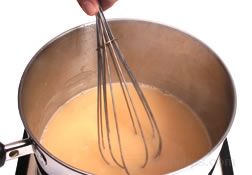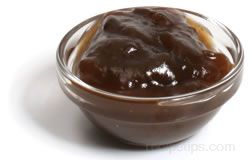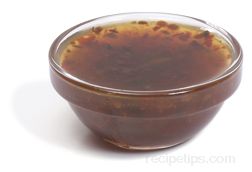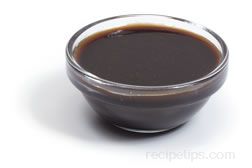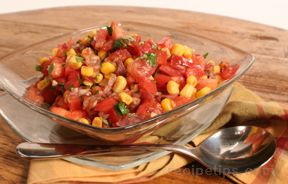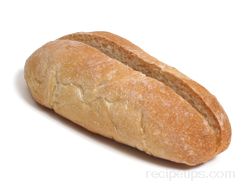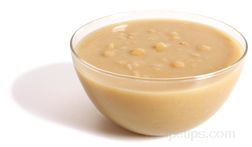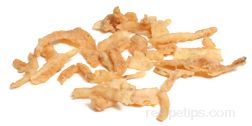White Sauces | Brown Sauces | Tomato Sauces (or Red Sauces) | Egg Yolk and Butter Sauces
Egg Yolk and Oil Sauces | Oil and Vinegar Sauces | Flavored Butter Sauces
White Sauces
| In French cooking, traditional white sauces are one of two types: those made with hot milk added to a white roux (such as Béchamel sauce or Mornay sauce) or sauces made with hot broth or stock added to a white roux (such as Velouté sauce). A roux is a combination of flour and butter that are cooked together to be used as a thickening agent for the sauce. The roux may be referred to as a white, blonde, or brown roux, depending on the amount of cooking time of the flour and butter mixture. The mixture increasingly darkens the longer it cooks. Once the roux is ready, the hot milk or stock is stirred into the roux to create a thick sauce that may be seasoned with herbs and spices. | |
Béchamel SauceA basic French white sauce made by adding hot milk to a white roux (heated butter mixed with flour). In an early era, cream was generally used instead of milk. The roux thickens the milk into a creamy white sauce. Some sauces refer to a blonde and a white roux, the difference being the length of time the flour or mixture was allowed to cook and thus become brown or golden tan in color. Seasonings can be added based on the type of dish served with the sauce and the flavors desired. |
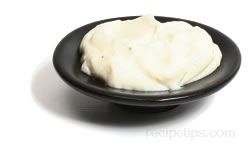 |
| A typical béchamel sauce begins by melting 3 or 4 tablespoons of unsalted butter in a saucepan on low heat and then mixing in 3 tablespoons of unbleached, all purpose flour. Turn the heat up to medium and cook the the mixture (referred to as the roux), allowing it to bubble but not turn brown as it cooks for 2 to 3 minutes. Whisk or stir the hot roux gently, letting it cool slightly and begin to add 1½ cups of milk, whisking the mixture so it becomes very smooth and thickens by whisking, which may take 4 to 5 minutes. Seasonings such a dash of salt, pepper, paprika, and nutmeg can be added as the sauce becomes smooth. If necessary, more milk can be added to thin the mixture. Remove the sauce from the heat and use it to pour over vegetables, pasta, poultry or fish dishes. | |
Mornay SauceA cheese sauce made by using Béchamel sauce (white sauce made by cooking flour and butter and then adding milk) as the base with Swiss and Parmesan cheese added to thicken and flavor the sauce. Some recipes suggest adding fish or chicken stocks to enhance the flavor or other ingredients, such as egg yolks, cream and/or butter to provide a richer flavor. Mornay sauce is commonly served over vegetables, eggs, various meats, poultry, and shellfish. |
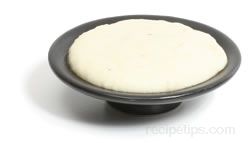 |
Veloute SauceOne of the basic white sauces of French origin, which is prepared from a white stock, such as chicken or seafood stock, and a roux. The roux is a thickening agent made from cooked flour and fat. Numerous variations of this sauce are made, such as sauce aurore (puréed tomatoes are added) or sauce supréme (cream and mushroom cooking stock is added). |
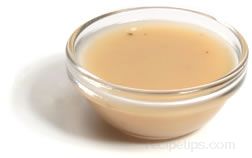 |
|
A typical velouté sauce begins by making a roux. A 6 to 4 ratio of flour and fat (usually whole butter or clarified butter) is cooked over moderate heat. (The actual quantity of flour and fat to use depends on the quantity of liquid added to the roux and the desired thickness of the sauce). While stirring for 2 to 3 minutes, the mixture should bubble and foam and the color should gradually darken the longer the roux cooks. A light yellow to golden yellow color is typical of a roux that will be used for a velouté sauce. It is important that the flour not burn, but it should be cooked thoroughly so that the resulting sauce will not attain a pasty, floury flavor. When the roux has cooked sufficiently, remove the pan from the heat to allow the roux to cool slightly. After the short cooling period, pour heated stock into the pan and return the pan to moderate heat. Vigorously whisk the liquid into the roux, reduce the heat to a low simmer, and continue stirring until the sauce becomes smooth. When the velouté sauce is ready to serve, stir in a small quantity of cream and season with salt and pepper to taste. Other seasonings can be added based on the type of dish that the sauce is accompanying. | |
Allemande or Parisienne SauceOccasionally referred to as Parisienne Sauce, Allemande Sauce is made by combining cream cheese, oil, lemon juice, and chervil. It is often spread over cold vegetables, most notably asparagus. | |
Brown Sauces
| In French cooking, brown sauces serve as a base for other similar sauces that are used as an accompaniment for meats and vegetables. Brown sauces are made from a brown meat stock and thickened with cornstarch or roux (flour cooked with butter). Some chefs suggest using arrowroot to thicken the sauce; however, it can be thickened according to personal preference and taste with ingredients best suited for the food being prepared. | |
Espagnole SauceAlso known as a brown sauce or demiglace, it is a basic sauce that serves as a base for use in making other variations of the original sauce. It has been simmered and reduced to half of its original volume, resulting in a very thick, intensely flavored mixture. Typically, espagnole sauce is made by mixing roux as a thickener into the espagnole and then adding other ingredients such as vegetables, spices, herbs, wine, and vinegar to enhance the flavor and aroma. This sauce is then used as a topping for meats and other foods or is used as a base to make other types of sauces. |
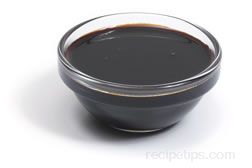 |
| A traditional French sauce, espagnole is one of the Grand or Mother sauces used as a base or foundation sauce for making smaller versions that are seasoned and flavored separately. Common sauces in this group that use espagnole as a base include Bordelaise, Chasseur, Chateaubriand, Diablo, Diane, Estragon, Lyonnais, Madera, Madeira, Moscovite, Mushroom, Piquant, Porto, Robert, Romaine, Tarragon, and Zingara. | |
DemiglaceA French term historically used to describe a traditional brown sauce, such as Espangnole, which has been simmered and reduced to half of its original volume, resulting in a very thick, intensely flavored mixture. This sauce is then used as a topping for meats and other foods or is used as a base to make other types of sauces. Today, the term demiglace is often used in reference to a much wider variety of sauces, such pan sauces and reduction sauces, which all use a brown stock as a base. |
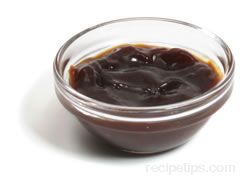 |
| A demiglace often contains half brown sauce (Espangnole) and half brown stock. Common sauces in this group include Bordelaise, Chasseur, Chateaubriand, Diable, Diane, Estragon, Lyonnais, Madera, Madeira, Moscovite, Mushroom, Piquant, Porto, Robert, Romaine, Tarragon, and Zingara. | |
Madeira SauceA wine sauce that is made from Madeira wine as the key ingredient. Although this sauce may consist only of Madeira wine and broth, there are also numerous variations that include other ingredients to enhance the flavors of the foods topped with the sauce. As an example, another version of the sauce may include the wine, a demiglace, water and/or broth, seasonings, and vegetables or mushrooms if desired that goes well with selected cuts of beef. Madeira sauces are typically used to season pasta, meats, stews, and savory dishes. | |
Tomato Sauces (or Red Sauces)
Tomato SauceA tomato product that is not as thick as tomato puree but thicker than tomato juice. It generally has its flavor enhanced by the addition of herbs, spices, onion and garlic. Tomato sauce is commercially canned and sold in most food stores. It is used as a base for other sauces and in a variety of dishes. The difference between tomato paste, tomato puree and tomato sauce is texture and depth of flavor. The thicker the consistency, the deeper the flavor. Tomato paste is the thickest in consistency, puree is thinner than paste, and tomato sauce is the thinnest. |
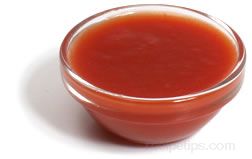 |
Tomato CoulisA coulis is a liquid or sauce made with ingredients, such as fruits or vegetables, which have typically been puréed and strained to create a thick sauce-like consistency. The sauce may be thick, but is still easily poured. When making a coulis, it is important to not over or under cook the ingredients, so the texture and flavor are not diluted if overcooked or too stiff and thick if undercooked. |
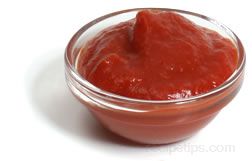 |
| Tomatoes are often used to make a coulis, serving as a base for tomato soups and sauces, or passattas, fish sautês, grilled fish, and fresh pasta dishes. Similarly, other fruits such as raspberries, blueberries and strawberries are made into a coulis to be served over foods such as cheesecake, ice cream, tortes, soufflés, crêpes, waffles, pancakes, and French toast. | |
Egg Yolk and Butter Sauces
Hollandaise SauceA sauce made with egg yolks that are beaten as they are warmed slightly. Butter is gradually added along with lemon juice to create a thick, creamy sauce. Hollandaise sauce is used to accompany egg dishes, boiled or poached fish, and a variety of vegetables. It is the mother sauce for all of the variations of egg yolk and butter sauces. |
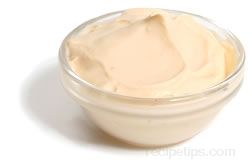 |
Béarnaise SauceA derivation of the traditional French hollandaise sauce, this sauce is made with egg yolks and butter. Instead of being flavored with lemon juice like hollandaise sauce, it is flavored with wine, vinegar, shallots, pepper, and tarragon. This sauce is most often served as a dressing over meat, fish, poultry, vegetables, and eggs. |
 |
Mousseline SauceThis term can apply to several different sauces or food dishes that all have a light, airy texture derived from using whipped cream or beaten egg whites added to the food dish immediately before it is served. The traditional Mousseline Sauce is a hollandaise sauce with whipped cream whisked into it prior to serving. When the term Mousseline is used to refer to a food dish, it will commonly refer to a savory dish containing meat, poultry, fish, or shellfish as the main ingredient. Typical of a Mousseline Sauce, either whipped cream or beaten egg whites are added just before serving to lighten the texture. | |
Normandy SauceA sauce consisting of fish stock, egg yolk, butter, and heavy cream, generally served with seafood but is also served with other foods. The ingredients may vary according to the type of food it is served with or because of regional preferences. Other ingredients used are mushrooms, apples, apple cider, and Calvados. | |
Egg Yolk and Oil Sauces
MayonnaiseMayonnaise is a sauce made with egg yolks, olive or vegetable oil, mustard, and lemon juice or vinegar, and various seasonings. It is one the mother sauces of French cooking and forms the base for a number of other sauces. Mayonnaise is an emulsion, which means that it is a substance created from the combination of two liquids that do not typically mix well, such as eggs and oil. Sauces or dressings that look like mayonnaise but which do not contain eggs as an ingredient, cannot be labeled as mayonnaise. Available as a traditional mixture of ingredients containing higher levels of fat, mayonnaise is also available in lighter versions that are considered low-fat and contain lower levels of fat content. Mayonnaise and its lighter versions are generally available in most food stores. |
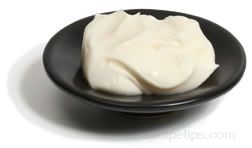 |
Remoulade SauceA classic French sauce made from mayonnaise, mustard, capers, chopped gherkins, anchovies, and fresh herbs. Typically made with a mayonnaise base, rémoulade is served cold as a condiment or dressing with vegetables, cold meats, fish, or shellfish. There are many versions of sauces referred to as Rémoulade sauce with a variety of ingredients, but the traditional sauce is commonly referred to as Sauce Rémoulade. |
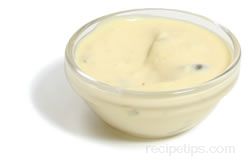 |
Tartar SauceA cold sauce used as a condiment most often with fish but also with other foods, such as vegetables. It is made with a mayonnaise base combined with ingredients such as chopped pickles, chopped onions, capers, olives, lemon juice or vinegar, and at times, it is lightly flavored with mustard. This sauce may also be referred to as tartare sauce. |
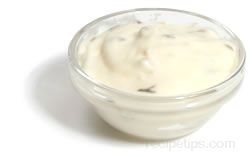 |
Verte SauceAn emulsion sauce made with mayonnaise as the base that is colored green with various other ingredients. Made to be served as a cold sauce, Verte Sauce or Sauce Verte as it is also known is often used as a condiment for fish and potato dishes. It is made by combining mayonnaise with the juice of herbs such as parsley and fresh spinach that are pureed together, giving the sauce a green or "verte" appearance. As versions of recipes evolve, the ingredients for this sauce have changed so that the Sauce Verte may include the juice as well as tiny bits of the spinach and herbs such as chervil, parsley, tarragon, and watercress. |
 |
Oil and Vinegar Sauces
Oil and Vinegar Sauce (Vinaigrette Salad Dressing)An oil and vinegar sauce, or vinaigrette, is a temporary emulsion, which means that the oil and vinegar (or wine) will quickly separate when not in motion. An oil and vinegar sauce is most often used as a salad dressing, but since the oil and vinegar separate so readily, the sauce is vigorously whisked or shaken immediately before using in order to keep the oil and vinegar in suspension. As a general rule, the ratio for making a vinaigrette sauce is three parts oil to one part vinegar or wine (or other acidic ingredient). Vinaigrettes can be enhanced with the use of different oils, but a balance is needed between the oils so that an oil with an intense flavor doesn't overpower a less intense oil. |
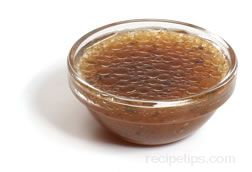 |
Flavored Butter Sauces
Beurre Blanc Sauce
Traditionally, this sauce is a white butter sauce native to France and is used to enhance a variety of foods, such as egg dishes, poultry, seafood, and vegetables; however, in many kitchens it is now also being made as a brown sauce. |
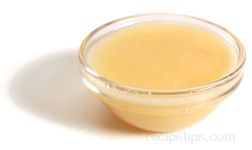 |
|
Beurre Blanc Sauce is typically made as an emulsion containing white wine, vinegar, minced or chopped shallots, unsalted butter, heavy cream (or water), and seasonings. Often considered as a difficult sauce to prepare, it is more time consuming than difficult. To prepare Beurre Blanc Sauce, the shallots, wine, and vinegar are combined and reduced by heating the mixture to only 10% of the original volume. The cream or water is added to the reduction and the butter is combined into the ingredients as it melts and is whisked to blend evenly. When finished, the shallots can be removed by straining the sauce or allowed to remain in order to add to the presentation appearance and texture. There are many variations of the traditional Beurre Blanc Sauce that can be made to provide a variety different versions and flavors. Some of the most common include Beurre Rouge, a red wine butter sauce (or versions of the sauce without wine such as Beurre Citron, a butter sauce, which uses lemon juice instead of wine); Beurre Fondu, an emulsified butter sauce; and Beurre Noisette, a nutty flavored sauce with lemon juice that employs a cooking procedure in which flavor is achieved by allowing the butter to brown. | |





